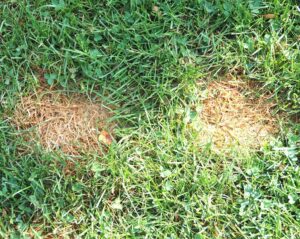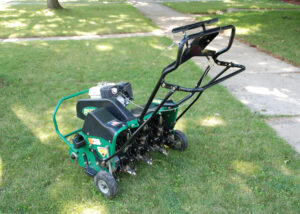The extreme heat and drought of 2021 across much of the country has turned many lawns brown. Damaged lawns may be thin, contain dead patches or are overrun with weeds.
Fall is a good time to improve the health and appearance of a weather-worn lawn. Start the process by evaluating the damage. Then plan a course of action and be prepared to follow through as needed with proper care.
Fall fertilization can help improve thin lawns and those with numerous small dead patches the size of a baseball or smaller. Apply fertilizer in early September to help lawns recover from summer stress while encouraging denser growth and deeper, more drought-tolerant roots.

Those in warmer climates growing grasses like centipede, Bermuda and zoysia should make sure the last fall application is at least one month prior to the average first killing frost. Use a low nitrogen, slow-release fertilizer that won’t harm stressed lawns and young seedlings if repairing or overseeding the lawn.
Give your lawn a boost by core aerating away problems like compacted soil and thatch.
Identify a thatch problem by using a knife to dig into the sod and check for the brown layer of partially decomposed grass known as thatch. If it is more than inch thick it is time to core aerate.
Heavily used lawns and those growing on clay soils are likely to be compacted. Dig down about 6 inches. If the grass roots only extend down about an inch or two, the soil is probably compacted and would benefit from core aeration.
Make your job easier and get better results by watering your lawn a couple of days before aerating.
 Rent a machine or hire a professional for this task. The core aerator creates openings in the turf allowing air and water to reach the soil and grass roots.
Rent a machine or hire a professional for this task. The core aerator creates openings in the turf allowing air and water to reach the soil and grass roots.
Run the aerator in two directions and leave the cores lay on the lawn. Once complete you can fertilize and even over seed thin or sparse lawns.
A bit more information: Prevent thatch problems with proper care. Avoid excess fertilization, especially in spring, that encourages lush dense growth that is more likely to develop thatch. Limit or better yet eliminate use of pesticides that impact the micro-organisms and earthworms that help decompose the thatch layer. Mow your lawn regularly removing only one third the total height of the grass. This is better for the health of the lawn and the shorter clippings break down quickly adding nutrients, moisture and organic matter to the soil.
Melinda Myers is the author of more than 20 gardening books, including Small Space Gardening. She hosts The Great Courses “How to Grow Anything” DVD series and the Melinda’s Garden Moment TV & radio program. Myers is a columnist and contributing editor for Birds & Blooms magazine and was commissioned by Gardener’s Supply for her expertise to write this article. Her web site is www.MelindaMyers.com.

